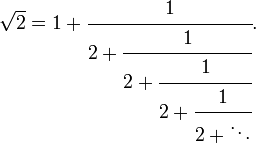Yesterday, I posed this math puzzle: Treating “^” as meaning exponentiation, and treating the exponentiation chain as going on infinitely, solve for x:
x^(x^(x^(x^(x^(x^…))))) = 2
Many people in the comments got the right answer — the square root of 2 — some people were unsure, so I thought I’d briefly blog a follow-up.
Here’s a way to figure it out: Let’s focus on the material in the outermost set of parentheses, which we set in bold below:
x^(x^(x^(x^(x^(x^…))))) = 2
That material is the same as the entire left-hand side of the equation, right? It’s x^(x^(x^(x^(x^…)))). But we were told as part of the problem what the left-hand side equals — it equals the right-hand side, which is 2. So substituting that in, we get
x^2 = 2
x must therefore be the square root of 2. No need for logarithms or anything more exotic. If you doubt the result, and want to see it illustrated, build an Excel spreadsheet with block A1 set to =sqrt(2) and A2 set to =sqrt(2)^A1, and then copy A2 down into another fifty-odd cells in column A. (The way Excel works, that will set each cell to sqrt(2) to the power of the previous cell, so A5, for instance, becomes =sqrt(2)^A4.) You’ll see the cells getting closer and closer to 2. Naturally, that’s not a mathematical solution — I began with the solution, once we assume that the question is correct and the series converges on 2 — but it might be a helpful illustration. (Note that proving that the series converges to 2 when x=sqrt(2), rather than solving the problem for x when we know the series converges to 2, is somewhat harder.)
The same technique might be familiar to some of you if you’ve ever studied chain fractions, such as (thanks to Wikipedia for the figure):

If you get rid of the 1+ on the left, and just call what’s left x, you see that
x = 1 / (2+x)
That means x^2 + 2x = 1, which means x^2 + 2x + 1 = (x+1)^2 = 2, or x = sqrt(2)-1. Bring back the 1+ on the left, and we see the chain fraction adds up to sqrt(2). Solving the chain exponentiation problem ends up using much the same sort of recursive solution.
UPDATE: I originally said that -sqrt(2) was also a solution, but a comment leads me to be uncertain of that, for reasons related to the zaniness of non-integer powers of negative numbers, so let me set that aside for now.